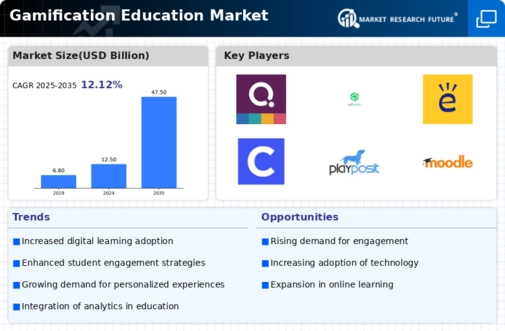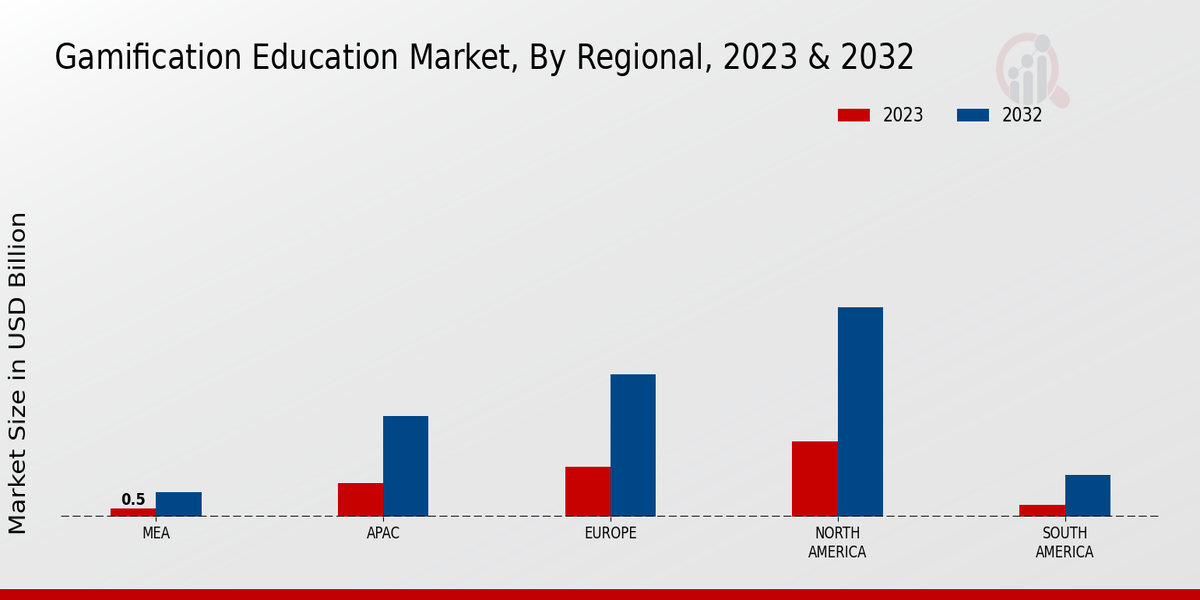Market Growth Projections
The Global Gamification Education Market Industry is projected to experience robust growth over the coming years. With an anticipated market value of 12.5 USD Billion in 2024 and a remarkable increase to 47.5 USD Billion by 2035, the industry is set to expand significantly. This growth is underpinned by a compound annual growth rate (CAGR) of 12.88% from 2025 to 2035. Such projections indicate a strong demand for gamified educational solutions, driven by technological advancements, increased focus on skill development, and the growing recognition of gamification's benefits. The market's trajectory suggests a transformative shift in educational practices, with gamification at the forefront.
Increased Focus on Skill Development
The Global Gamification Education Market Industry is driven by an increased emphasis on skill development in educational settings. As the job market evolves, educational institutions are recognizing the necessity of equipping students with relevant skills through gamified learning experiences. This approach fosters critical thinking, problem-solving, and collaboration among students. The market's growth trajectory, with a projected CAGR of 12.88% from 2025 to 2035, reflects the rising demand for innovative educational solutions that prepare students for the workforce. By integrating gamification into curricula, institutions aim to enhance employability and ensure that graduates possess the skills needed in a competitive job market.
Global Collaboration and Partnerships
Collaboration among educational institutions, technology providers, and content creators significantly influences the Global Gamification Education Market Industry. Partnerships facilitate the development of comprehensive gamified learning solutions that cater to diverse educational needs. For instance, collaborations between universities and tech companies lead to the creation of interactive platforms that enhance student engagement. This collaborative approach not only enriches the learning experience but also accelerates the adoption of gamification in education. As the market continues to evolve, such partnerships are likely to play a crucial role in driving innovation and expanding the reach of gamified educational solutions.
Rising Demand for Interactive Learning
The Global Gamification Education Market Industry experiences a notable increase in demand for interactive learning methodologies. Educational institutions are increasingly adopting gamified approaches to enhance student engagement and motivation. This shift is evidenced by the projected market value of 12.5 USD Billion in 2024, indicating a growing recognition of the effectiveness of gamification in education. By incorporating game elements into curricula, educators aim to create immersive learning experiences that cater to diverse learning styles. This trend is likely to continue, as schools and universities seek innovative solutions to improve educational outcomes and foster a more dynamic learning environment.
Technological Advancements in Education
Technological advancements play a pivotal role in the expansion of the Global Gamification Education Market Industry. The integration of artificial intelligence, virtual reality, and mobile applications into educational platforms enhances the gamification experience. These technologies facilitate personalized learning experiences, allowing educators to tailor content to individual student needs. As a result, the market is expected to grow significantly, reaching an estimated 47.5 USD Billion by 2035. The continuous evolution of technology in education not only improves engagement but also provides valuable data analytics for educators to assess student performance and adapt their teaching strategies accordingly.
Growing Awareness of Gamification Benefits
The Global Gamification Education Market Industry benefits from a growing awareness of the advantages associated with gamified learning. Educators and administrators increasingly recognize that gamification can lead to improved student retention, higher motivation levels, and enhanced learning outcomes. This awareness is fostering a shift in educational practices, with more institutions exploring gamification as a viable strategy. As the market matures, the emphasis on research and case studies demonstrating the effectiveness of gamification will likely contribute to its widespread adoption. Consequently, the market is poised for substantial growth, driven by the collective understanding of gamification's potential to transform education.



 Source: Primary Research, Secondary Research, Market Research Future Database and Analyst Review
Source: Primary Research, Secondary Research, Market Research Future Database and Analyst Review
















